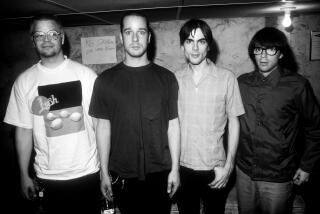Fuzz rocks hard on head-banging ‘Fuzz II’
Fuzz, “Fuzz II” (In the Red). As evidenced by its title, the second record by the Los Angeles rock band isn’t out to make some grand statement on the meaning of life. The trio that built it isn’t interested in hooking listeners with cleverness or outward displays of smarts. Best known for its drummer, garage rock master Ty Segall, Fuzz harnesses distorted guitar (Charles Moothart), bass (Chad Ubovich) and drums to build solid-as-marble rock songs. Think Deep Purple, Mudhoney, Black Sabbath, Kyuss: rock whose sense of purpose is to drive longhairs to bang heads, finger invisible fret boards and crash Keith Moon-style on air drums.
“Bringer of Light” is built on a Sabbath-paced riff, one that crawls as though wading through mud. “Burning Wreath” rings in the holiday season with a grungy freakiness: “Free speech, cut my teeth/ Lie beneath the burning wreath/ Hot coal, melted soul/ Pays the toll and breaks the mold.” The record is available on streaming services and as a download, but “Fuzz II” works best when absorbed as intended: on a double LP with a grand gatefold sleeve. By the time Side 4 arrives, the massive album closer, “II,” storms in like its own “Sister Ray”: heavy and relentless.
L.A. Takedown, “L.A. Takedown” (Ribbon Music). Those looking to take a road trip without leaving the house would do well to get behind the virtual wheel for “L.A. Takedown.”
The new single-track instrumental album by Los Angeles-based artist Aaron M. Olson (who also records under the name L.A. Takedown) runs 41-plus minutes and, like Kraftwerk’s “Autobahn,” the composition has a cinematic vibe that lends itself well to visuals. On Olson’s website, the work plays in a continuous loop over videos of L.A. sunsets in real time, and the result is an experience that conjures a distinctly local vibe. You halfway expect the track to make a pit stop at Ed Ruscha’s Standard gas station.
Kraftwerk and its experimental peers in the so-called Krautrock movement of the early 1970s are the obvious touchstone. Navigating musical curves and straightaways with the smoothness of a Tesla rolling along Pacific Coast Highway, the track is driven by the so-called Motorik beat, which propelled many great German jams and drives newer tracks by the likes of LCD Soundsystem, Wilco and Queens of the Stone Age.
Like Ricardo Villalobos’ epic of minimalist techno, “Fizheuer Zieheuer,” or Sleep’s hour-long stoner-rock jam “Dopesmoker,” the sheer length of “L.A. Takedown” gives it a certain weight. But its relentless drive and fascinating sonic architecture also lend it depth, and the result is a work that seems to loop through the hills, valleys and grids of Los Angeles.
Though the full “L.A. Takedown” track can be heard at the official website, for the full effect, download the free high-resolution .wav file and explore its many intricacies.
Oneohtrix Point Never, “Garden of Delete” (Warp Records). One depressing truth regarding the volume of music being issued in 2015 is that it’s still rare to discover notably original works amid the mess of karaoke-style imitations. “Garden of Delete,” the strange, surreal new album by composer Daniel Lopatin under his Oneohtrix Point Never guise, is one such singular creation. A dense, kaleidoscopic mix of instrumentation — analog synthesizers, the occasional acoustic or electric guitar, shards of digitized noise, cathedral organs, late 1970s synth-pop and sampled and manipulated voices — “Garden of Delete” delivers fresh tones and textures with wonder and glee.
The artist filters divergent influences through his shuffle-play-style compositions. Parts of “Sticky Drama,” for example, race with distorted energy that suggests Norwegian black metal — except built with rusty synthesizers and digitized bass-drum kicks. “Child of Rage” opens with creepy sampled dialogue of a man and boy before moving into a meditation that rejoices amid a rainbow of Giorgio Moroder-esque frequencies.
The record’s dozen songs, some as short as 28 seconds, others running more than eight minutes, are consistently restless. This isn’t snooze music; few measures pass without some shocking twist or turn. The result is a record that demands intentional listening, and it rewards such focus with boundless detail.
More to Read
The biggest entertainment stories
Get our big stories about Hollywood, film, television, music, arts, culture and more right in your inbox as soon as they publish.
You may occasionally receive promotional content from the Los Angeles Times.







